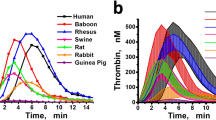Abstract
Changes in plasma activated partial thromboplastin times (APTT) and prothrombin times (PT) in mice, rats, rabbits, dogs, monkeys and human were examined for up to 96 h at storage temperatures of 4 and 25°C. Prolongation of APTT in rats was rapid and marked, with times doubling within 24 h post-sampling. Plasma APTT of human and monkey were also affected, but to a lesser extent. No effect was observed in mice, rabbits and dogs. On the other hand, the magnitude of PT changes was much smaller than that observed with APTT in all species. No significant differences were noted between the results from samples stored at 4°C or 25°C for either test.
The false prolongation of APTT is clearly undesirable in a toxicity study, especially in rats. It is important therefore to minimise these changes by performing this test under strict time-controlled conditions.
Similar content being viewed by others
References
Dameron GW, Weingand KW, Duderstadt JM et al. (1992) Effect of bleeding site on clinical laboratory testing of rats: orbital venous plexus versus vena cava. Lab Anim Sci 42:299–301
Edwards CJ (1994) The orbital venous plexus as a sampling site for coagulation testing: the continuing saga. Comp Haematol Int 4:236–238
Edwards CJ, Fuller J (1993) Effect of bleeding site on coagulation results in the Charles River outbred albino SD rat. Comp Haematol Int 3:40–42
Green CE, Tsang CW, Prestwood AK et al. (1981) Coagulation studies of plasmas from healthy domesticated animals and persons. Am J Vet Res 42:2170–2177
Gregoor S, Harvey MS, Briet E et al. (1993) Coagulation parameters of CPD fresh-frozen plasma and CPD cryoprecipitate-poor plasma after storage at 4°C for 28 days. Transfusion 33:735–738
Hall RL (1992) Clinical pathology for preclinical safety assessment: current global guidelines. Toxicol Pathol 20:472–476
Janson TL, Stromorken H, Prydz H (1984) Species specificity of tissue thromboplastin. Haemostasis 14:440-444 Kase F (1978) The effect of homo- and heterologous thromboplastins on plasmas of man, seven mammalian and two avian species: a comparative study. Comp Biochem Physiol 61A:65–68
Koepke JA, Rodgers JL, Ollivier MJ et al. (1975) Pre-instrumental variables in coagulation testing. Am J Clin Pathol 64:591–596
Lenahan JG, Phillips GE (1966) Some variables which influence the activated partial thromboplastin time assay. Clin Chem 12:269–273
Masson RG, Read MS (1971) Some species differences in fibrinolysis and blood coagulation. J Biomed Mater Res 5:121–127
Matsuura M, Satoh S, Takano K et al. (1988a) Vitamin K-reversible hypoprothrombinemia in rats I. Sex differences in the development of hypoprothrombinemia and the effects of beta-lactam antibiotics. Jpn J Pharmacol 46:303–310
Matsuura M, Satoh S, Kobayashi F et al. (1988b) Vitamin K reversible hypoprothrombinemia in rats II. Efficacy of vitamin K on latamoxef-induced coagulopathy in rats. Jpn J Pharmacol 47:357–365
Matsuzawa T, Tabata H, Sakazume M et al. (1994) A comparison of the effect of bleeding site on haematological and plasma chemistry values of F344 rats: inferior vena cava, abdominal aorta and orbital venous plexus. Comp Heamatol Int 4:207–211
Mifsud CV (1979) The sensitivity of various thromboplastins in different animals species. Pharmacol Ther 5:251–256
Owen CA, Bowie EJW (1978) Rat coagulation factors V, VIII, XI and XII: Vitamin K dependent. Haemostasis 7:189–201
Salemink PJM, Korsten J, Leeuw P (1994) Prothrombin times and activated partial thromboplastin times in toxicology: a comparison of different blood withdrawal sites for wistar rats. Comp Haematol Int 4:173–176
Shlosberg A, Egyed MN (1986) Stability of prothrombin times in sheep dosed with natural and synthetic anticoagulants. Res Vet Sci 40:141–143
Shum Y, Griminger P (1972) Prothrombin time stability of avian and mammalian plasma: effect of anticoagulant. Lab Anim Sci 22:384–387
Thomson JM, Easton AC, Faragher EB (1983) The use of vacutainer tubes for collection and storage of blood for coagulation testing. Clin Lab Haematol 5:413–421
Weingand K, Bloom J, Carakostas M et al. (1992) Clinical pathology testing recommendations for nonclinical toxicity and safety studies. Toxicol Pathol 20:539–543
Uchida K, Nomura Y, Takase H et al. (1986) Effects of vitamin K-deficient diets and fasting on blood coagulation factors in conventional and germ-free rats. Jpn J Pharmacol 40:115–122
Author information
Authors and Affiliations
Rights and permissions
About this article
Cite this article
Tabata, H., Nakamura, S. & Matsuzawa, T. Some species differences in the false prolongation of prothrombin times and activated partial thromboplastin times in toxicology. Comparative Haematology International 5, 140–144 (1995). https://doi.org/10.1007/BF00638933
Issue Date:
DOI: https://doi.org/10.1007/BF00638933




